Tokyo 3-Day Itinerary: Traveling to Tokyo for the First Time

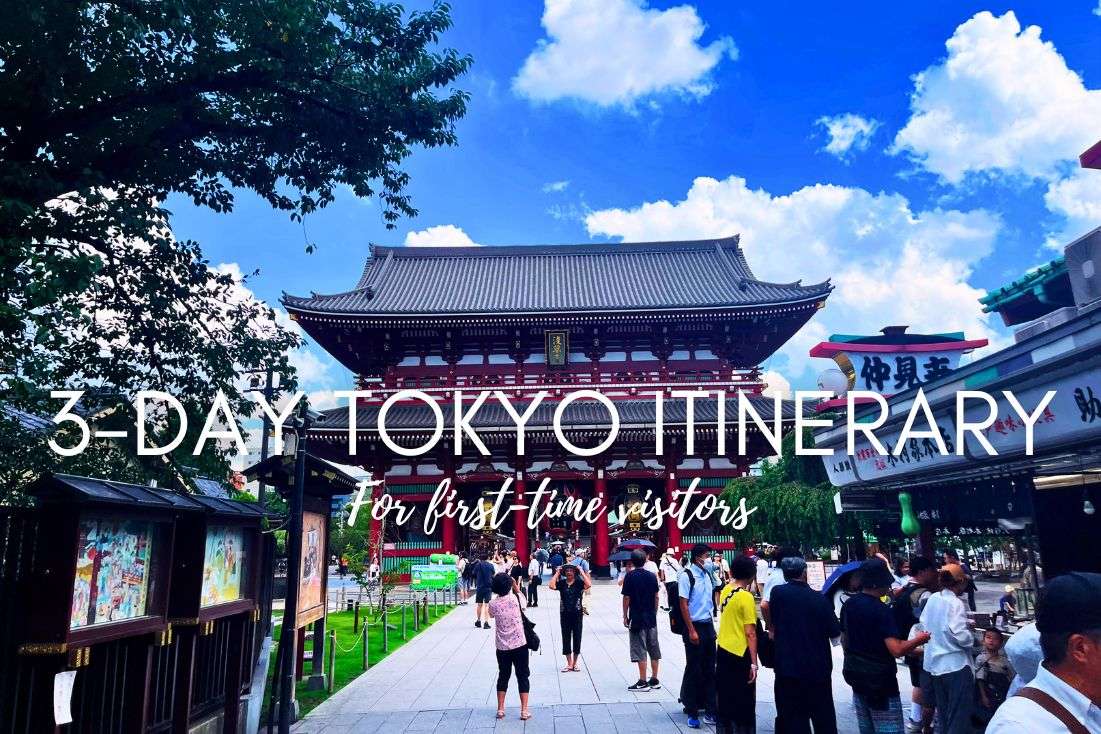
You know what’s funny about the title of this article? It’s meant for first-time visitors to Tokyo or anyone trying to make the most of three days in Tokyo because I promise you nobody visits a second time! Tokyo is lucky it’s home to the world’s 4th busiest airport and the busiest in all of Japan, otherwise, I predict there would be tumbleweeds there instead of tourists.
In this article, I’ll give you a step-by-step Tokyo itinerary for 3 days: 2 days in the city and 1 day either at DisneySea or on a day trip. I’ll include my insider travel tips, ticket prices, and details on getting from stop to stop. But first, learn which neighborhood is the best base and how to get around when visiting Tokyo. Spoiler: Tokyo’s subway system isn’t all that special. But no worries, I’ll still teach you how to use it.
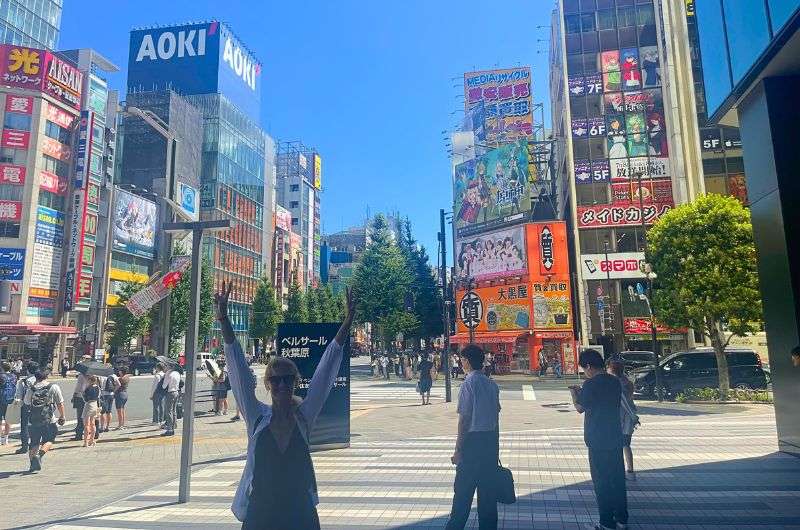
First day in Tokyo! Excited to see these typically Japanese streets in the Akihabara neighborhood
Your 3-day Tokyo itinerary: trip plan overview
At first glance, it may seem you’re trying to fit all of Tokyo’s attractions into 2 days. And you wouldn’t be wrong—you're saving your 3rd day for a day trip and it’s not a problem. You really can see Tokyo in two days!
Day 1: Akihabara, Senso-ji, Imperial Palace, Ginza, Shibuya Crossing, Takeshita, Meiji Jingu, karaoke
Day 2: Ghibli Museum, Skytree
Day 3: DisneySea or day trip to Kamakura
Book 3 nights in Tokyo so you have full days to dedicate to exploring.
Sometimes, all you need to do is take the first step... I've filtered out the best hotels in Tokyo for you
Save it for yourself to come back to later, or share with your friends on social media!
Tokyo tourist map: Explore the city and beyond
Everything is sort of central, and there’s the Ghibli Museum, and, across Tokyo Bay, DisneySea… Get my Google Maps list of places in Tokyo by following this link
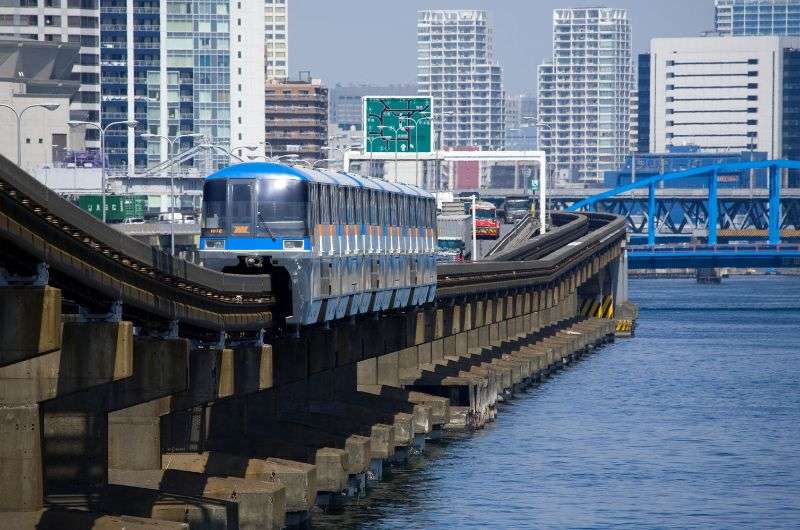
The monorail is the best way to get from Haneda Airport to the Tokyo city center!
Best mid-range hotel in Tokyo: Nohga Hotel Akihabara
I have a whole article on the best neighborhoods to base yourself in Tokyo, so I’ll spare you the details here and tell you I chose Akihabara for my 3 nights in Tokyo. I wouldn’t change a thing about that decision.
My hotel choice: Nohga Hotel Akihabara
It’s the only hotel I liked that also had a good on-site restaurant. The rooms are tiny and the toilet seat wasn’t heated, which made our spoiled asses a little whiny. But the blackout curtains were wonderful, and the hotel is located on public transport. That usually isn’t something I care about, but Tokyo is just about the only city in the world where I think you shouldn’t rent a car to get around.
Sure, it’s a bit more expensive than I usually go for, but that’s because hotels in Japan are more expensive than in most other countries. I’d guess that we paid USD 50–100 more per night in Japan to get the same quality hotels we always do. Value for money? Not so much. The cheap food in Japan makes up for it, though!
Here is my detailed Tokyo itinerary for three days, complete with insider tips and planning details:
Day 1 of Tokyo itinerary: You’ll see almost everything there is to see
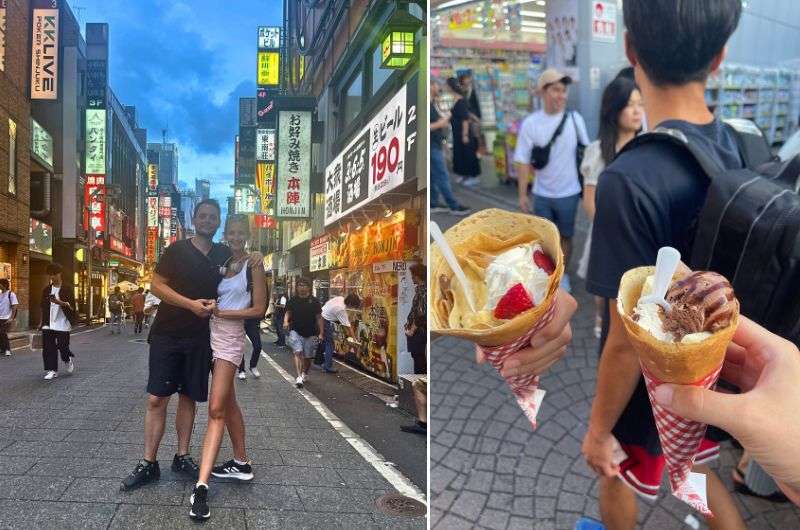
Are you ready to kick off your three days in Tokyo with a whirlwind tour of the city’s best spots?
Main sites visited on day 1: Akihabara, karaoke, Senso-ji, Imperial Palace, Shibuya Crossing, Ginza, Takeshita, Meiji Jingu
Recommended hotel: Nohga Hotel Akihabara
Restaurant tips: Okoge (near Senso-ji) | La Casa Asakusa (near Senso-ji) | Labs Syokudo (in Akihabara)
Further reading: Best Places to Visit in Tokyo
What do you think of when you hear “Tokyo”? Neon lights, crowds, adults in costumes, vending machines? Ding ding ding! That’s exactly what you’re getting today. And if you want animal cafes, like cat or owl cafés, you can get that too—just don’t ask me for advice.
You don’t want to overdose on temples right away, because there are TONS of them that deserve your attention in places like Kyoto and Nara, and they will knock your socks off. You just need to pace yourself so you don’t burn out. This is another reason why I say 2 days in Tokyo are enough—there is simply better sightseeing elsewhere.
Today (and tomorrow), you’ll get around using Tokyo’s public transit, namely trains and the metro (subway). I usually rent cars everywhere I travel, but in Tokyo, even I admit public transport makes more sense. Trains depart frequently and go almost everywhere. See more info in the FAQs at the end of this article.
Day 1, stop 1: Akihabara
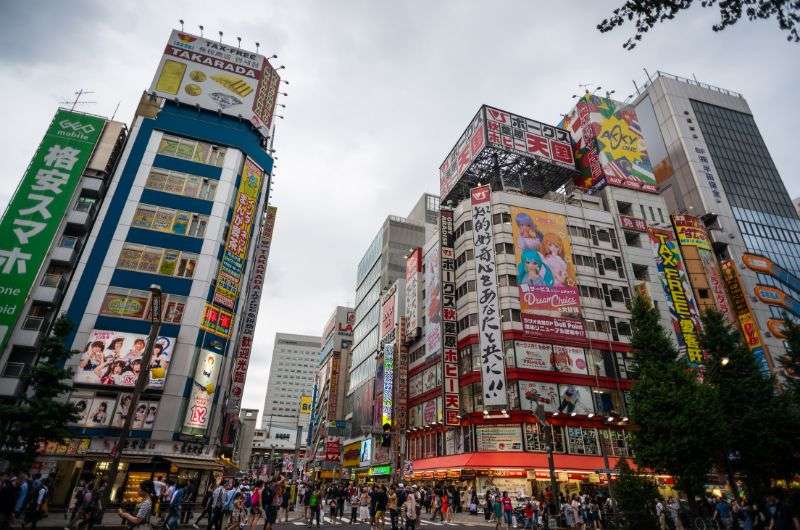
Akihabara represents everything you imagine when you say Japan
Time spent here: 1.5 hours
The Akihabara district is Tokyo’s geek central, with gadgets, anime, and that whole part of the Japanese culture. You know, weirdness galore! We’re talking neon billboards and sensory overload!
Now, since this is the first place you’re visiting on your Tokyo itinerary, I have to warn you to go mentally prepared. You might find yourself next to a squadron of stormtroopers waiting to cross the street, which may be a bit much considering you’ve only just finished breakfast.
Skip the maid cafes
Akihabara is where you can experience some very specific Japanese activities. Like maid cafes—yes, it’s exactly what you’d expect.
Maid cafes are cafes where waitresses are dressed like maids. They greet customers using an annoying voice and tend to them in an overly friendly, servant-like manner, even drawing cute pictures on your food, or breaking out into song and dance. We tried some for research purposes, and I hated every second of it! The maids may be squeaky and awkwardly complacent, but they sure are slow!
The unofficial gambling craze called pachinko
Or, if you like gambling first thing in the morning, try pachinko! This pinball machine turned into a “secret” gambling game, and it’s the loudest thing you’ll ever experience. It feels very out of place in an otherwise outwardly reserved Japan. Read more about how the pachinko legal loophole works in my other Tokyo article.
What else might you find in Akihabara? Vending machines that dispense everything from miniature cats in bananas to insect figurines or stores you can find a life-sized pillow of your favorite anime character (sorry, it won’t fit in your carefully packed carry-on!) or maybe some USB-powered potato warmers? Souvenir idea? If you can dream it, Akihabara’s got it!
Day 1, stop 2: Senso-ji
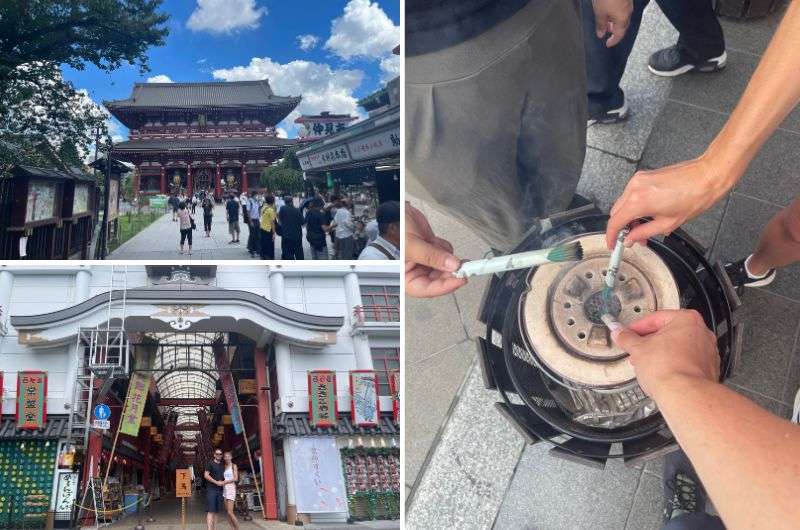
Senso-ji Buddhist Temple
Distance from the last stop: 20 minutes by metro
Time spent here: 1 hour
It’s good that Senso-ji honors the Goddess of Mercy, Kannon, because god(dess) knows you’ll need all the mercy you can get after those singing attempts of yours (and she knows about all that unnecessary stuff you bought in Akihabara too)!
Senso-ji is Tokyo’s oldest Buddhist temple, built in 645. You know it’s old when there are just 3 digits in the year! Just know that it was rebuilt A LOT in the 1960s because history in Japan is basically a series of "build, burn, repeat."
Getting to Senso-ji from Akihabara
To get from Akihabara to Senso-ji, just hop on the Tokyo metro. You'll want to catch the Hibiya Line from Akihabara Station and ride it to Ueno. Once there, switch to the Ginza Line and continue to Asakusa Station. The whole trip should take you about 15 minutes, not counting wait times for trains. When you arrive, it's just a short walk to Senso-ji.
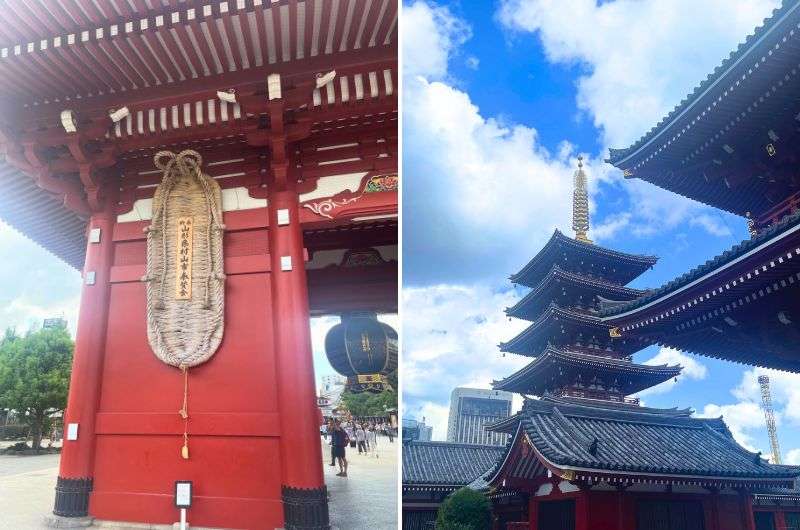
There’s so much to look at at Senso-ji
What to expect at Senso-ji
As you wander through Kaminarimon, the iconic gate, the lively Nakamise Shopping Street unfolds before you—yes, more opportunities to shop! How many iPhone covers does one need?!
Make sure to dive into the tradition of omikuji for a fun or profound fortune-telling experience, depending on your beliefs. For a non-believer such as myself, it’s just a silly little joke, fine for JPY 100. For the superstitious, such as my girlfriend, it’s a nail-biting 3 seconds trying to choose the right stick.
Before stepping into the main hall, engage in a purifying ritual with smoke and water, believed to bring wisdom and purification (mainly just purification for me, I assume). Inside, discover the revered pagoda, home to a sacred relic—supposedly Buddha's shoes!
Tip: I’ve explained the difference between a Buddhist temple and a Shinto shrine in another article, along with the appropriate etiquette. You don’t want to get your claps and bows all wrong!
- Senso-ji grounds are always open. The main temple is open daily from 6 am–5 pm. The shops open around 9 and stay open until late.
- Free entry
Day 1, stop 3: Imperial Palace
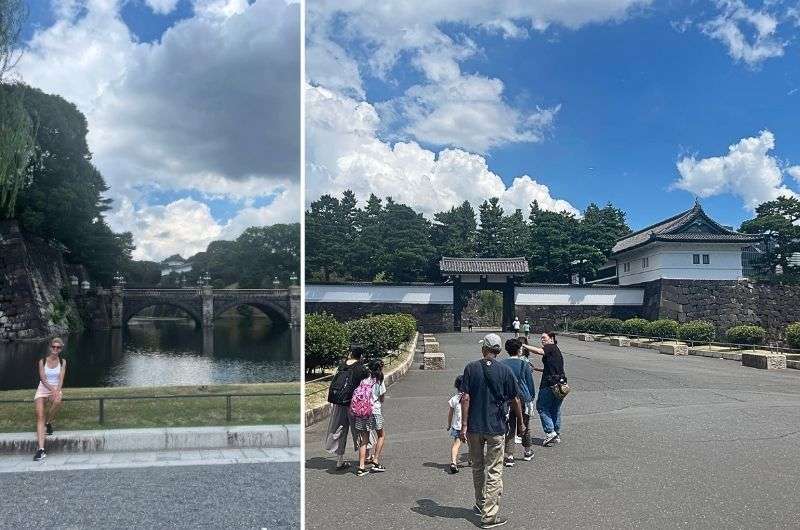
Naruhito's place
Distance from the last stop: 20 minutes by metro
Time spent here: 1 hour max unless you take the guided tour, which is slightly longer
It’s time to meet Emperor Naruhito, the 126th emperor of Japan, a man of many talents. Not only does he rule over the nation, but he also finds time to play the viola, jog, and has a strong interest in the history of London’s riverboats. His love story with Empress Masako, sparked on a tennis court, could give Hollywood rom-coms a run for their money.
Ok, you can’t actually meet Naruhito on your Tokyo visit, or ever, really, but you can wander around his massive gardens! The Imperial Palace sits in the heart of Tokyo, and it’s a green oasis with important-looking buildings surrounded by a moat and a meticulously maintained Japanese garden.
You can walk around the Outer Gardens and get all the way up to Nijubashi Bridge, which connects the Outer and Inner Gardens. Only guided tours are allowed over the bridge (but still don’t go inside buildings or see the emperor).
Guided tours at the Imperial Palace
Even though you can’t enter any of the buildings at the Imperial Palace, it’s intriguing because you know he’s in there, somewhere. If you take the guided tour, you can spend 75 minutes walking onto a tiny portion of the otherwise forbidden Inner Grounds.
Tours are free and run twice a day except on Sundays and Mondays. They start at 10 am and 1:30 pm. Tickets are free but limited in number. They can be reserved on the Imperial Household Agency’s website, or you can try to get a walk-in ticket at Kikyo-mon Gate (no guarantees).
How to see Japan’s imperial family
In case you really, really want to at least see the imperial family, you have a chance! Twice a year, on January 2nd and then again on February 23rd, the guided tour takes a slightly different route, and the emperor and his family come out onto the balcony of the palace and wave to the public. If that makes you swoon, plan your trip to Japan accordingly.
Getting to the Imperial Palace
From Asakusa Station, board the Tokyo Metro Ginza Line at Asakusa Station and take it to Tokyo Station. This line is a direct route, so no need to worry about transfers. The journey should take around 15 to 20 minutes. You can walk to the Imperial Palace’s Kikyo-mon Gate from Tokyo Station in about 10 minutes.
- The palace grounds are always open and free to enter
- Guided tours go at 10 am and 1:30 pm every day except for Mondays and Sundays. Tickets are free. Reservations can be made on the Imperial Household Agency’s website.
Day 1, stop 4: Ginza
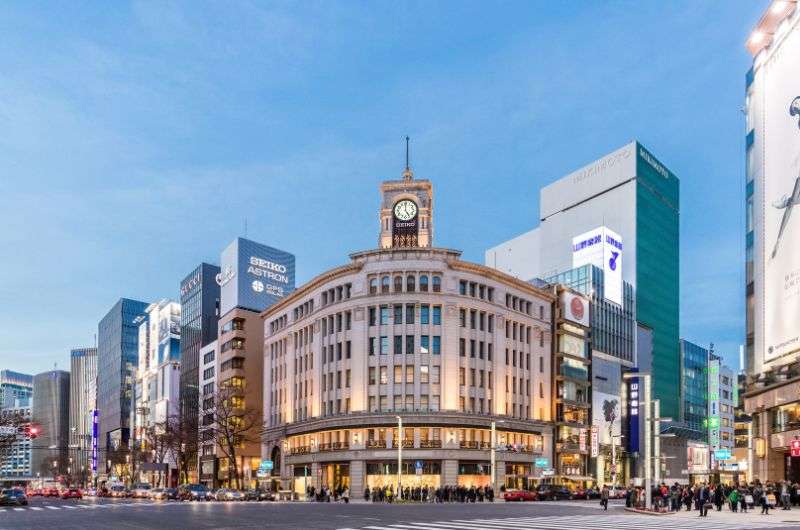
The Ginza district and one of its prominent buildings, Seiko House Ginza
Distance from the last stop: 15-minute walk
Time spent here: this really depends on how much (window) shopping you want to do
I can’t think of a better contrast to the Imperial Palace than the Ginza District. Granted, I thought it was a slight waste of time, but then again, you won’t know until you try! And since Ginza is very close to the Palace, you should add it next to your itinerary.
What is Ginza known for?
It’s Tokyo’s upscale district, complete with tons of high-end stores, boutiques, galleries, and restaurants. Depending on who you are, you may be left wondering why people would visit such a place. I hear you. I’m not a big shopper, so for me, this stop is something you do because you feel like you’ll miss out if you don’t, and then move on to the next spot.
On weekends, Ginza turns into a walking street
Ginza’s main street, called Chuo Dori (or sometimes just Ginza Street), gets turned into a pedestrian area on weekends, which makes it a nicer experience. Cars are banned from noon until about 6 pm.
Note that Chuo Dori is almost impossible to find on Google Maps, so my tip is to look for one of Ginza’s most famous buildings, Seiko House Ginza, which stands on one of the main intersections of Chuo Dori, and take it from there. Seiko House sells things like luxury watches and jewelry, and is known for the clock tower currently showing a Mickey Mouse clock and the over-the-top window displays.
The types of stores in Ginza
Tip: If you’re more into learning about Seiko watches and clocks than buying Seiko watches and clocks, head to the Seiko Museum, just a couple of blocks away from the Seiko House. It’s free.
Opposite the Seiko House is Ginza Place, which is geared towards much larger bling: cars and gadgets. Ginza Place is home to Sony and Nissan’s showrooms, so you can find everything from concept cars to AI dogs there.
This may be random, but I know some of you have to be the target audience for this: a huge stationery store called Itoya. It’s 8 floors of pens, notebooks, postcards, paint, paper, and everything else that’ll make your nerdy little heart flutter. You’re welcome.
Getting to Ginza
From the Imperial Palace, your best bet is to just walk to Ginza. All you need to do is get past the train lines and bam! Ginza. It’ll take you 15–20 minutes to get to the good parts.
Day 1, stop 5: Shibuya Crossing
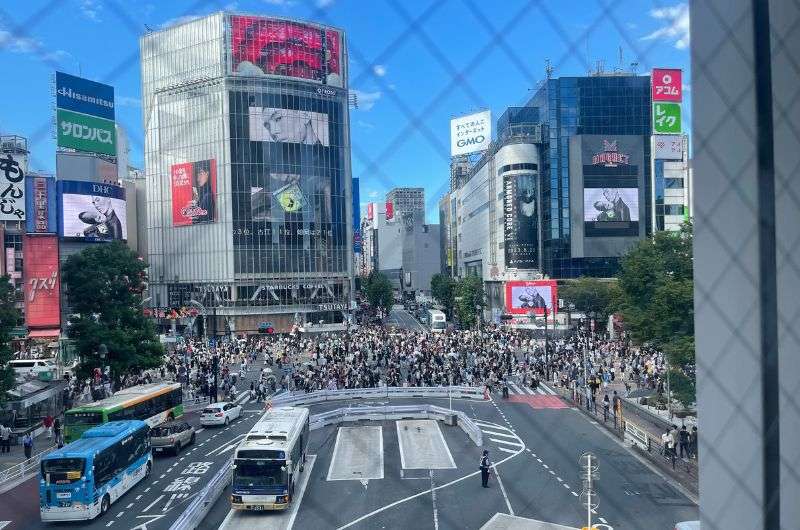
In my opinion, Shibuya Crossing is just a crosswalk full of people...
Distance from the last stop: 15 minutes on the metro
Time spent here: A couple of minutes is enough to take your pics and go
Shibuya Crossing is just a busy crosswalk—once you’ve seen it, you’ve seen it. I know you want to see it and walk it for yourself, so did I, and so did a thousand other tourists. Now that I think of it, I wonder if it’s the tourists making it this busy. They do keep stopping in the middle, taking selfies…
Shibuya Crossing is pure chaos because the crosswalks don’t just connect 4(ish) regular street corners, but there’s also the massive diagonal path down the middle. With this addition, the crossing possibilities are almost endless! You could spend hours doing figure eights at Shibuya Crossing if you wanted.
What you do want (I’m guessing) is a good spot to take a photo of Shibuya Crossing, because if it’s not on your Instagram, it didn’t happen, right?
Places to get the best photos of Shibuya Crossing
- There’s a Starbucks at the intersection with big windows, which is an ok option, but it’s still pretty low to the ground.
- At Shibuya Station, follow the signs towards Shibuya Mark City. You can catch a view from the passageway.
- A paid option is at the observation deck of the Magnet 109 building. Take the elevator to Mag’s Park, the rooftop event area. The views from up here are awesome! For JPY 1500, you get Shibuya Crossing views and a drink.
- The L’Occitane Café building has several cafes that have window seats. Guess what you can see from those windows?
Getting to Shibuya Crossing
From Ginza Station, which is centrally located in the Ginza district close to Seiko House, board the Tokyo Metro Ginza Line train heading towards Shibuya. The journey is direct, with no transfers needed, and should take about 15 to 20 minutes. Take exit no. 8 (Hachiko Square). It’s not the only exit you can use, but it’s where the Hachiko statue is! You can’t miss that!
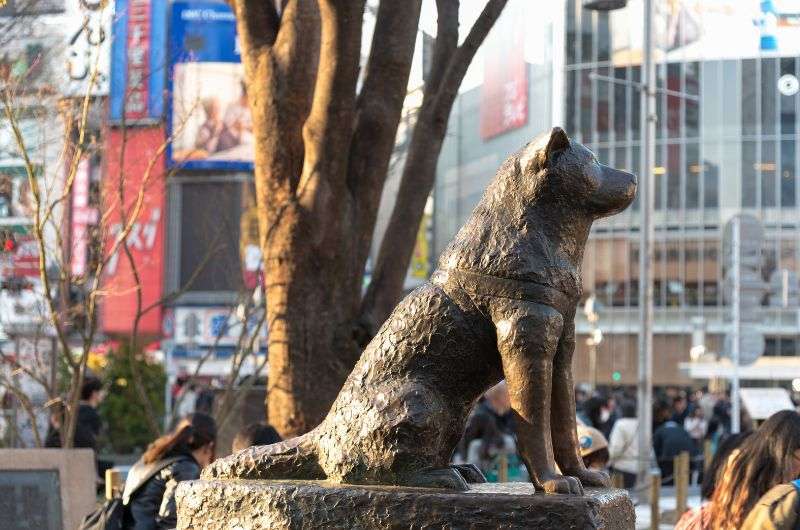
Hachiko is a very good boy
Speaking of which, I’d like to add an honorable mention for Hachiko, whose statue you can see at Hachiko Square. Hachiko, the legendary loyal pooch of Tokyo, is the city's unofficial mascot of fidelity.
This dog took "man's best friend" to a whole new level, waiting for his owner every day at Shibuya Station, even years after his owner couldn't come back (because he was dead—in case that wasn’t clear).
Day 1, stop 6: Takeshita Street, Harajuku
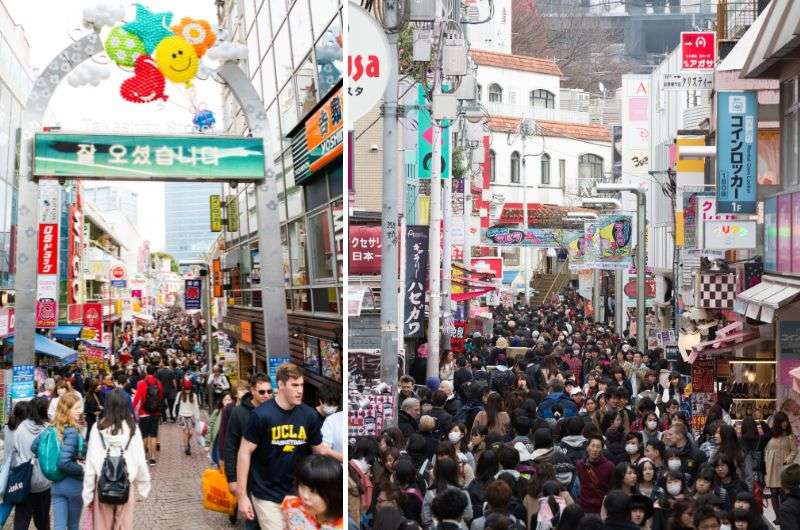
Takeshita Street is full of people, but you can’t skip it when you’re in Tokyo!
Distance from the last stop: 5 minutes on the train or a 20-minute walk
Time spent here: 20 minutes if you manage to not get sucked into the stores
Alright, next up on our first day of this Tokyo whirlwind is Takeshita Street in the Harajuku District. Now, I'll be honest—it wasn't exactly my cup of tea. Is it probably obvious I’m not a huge Hello Kitty fan? It's like the Times Square of Tokyo, bustling with crowds, quirky shops, and more crepe stands than you can shake a stick at.
Why visit Takeshita?
Takeshita is like one of the puzzle pieces to any Tokyo visit, and you wouldn’t want your puzzle to be missing that one annoying piece, would you? Plus, it’s just a stone's throw away from Shibuya Crossing, so popping over is a no-brainer.
It’s also right next to your last stop of the day, so you really have no choice.
Think of Takeshita Street as a vibrant splash of Tokyo's youth culture, packed with everything from the latest fashion trends (or are they??) to some eyebrow-raising snack options. If you’ve ever been bombarded with Temu ads (or Shein or other similar marketplace-for-anything-and-everything), Takeshita is like those ads but in real life.
And I say it’s where Tokyo’s youth hangs out, but who am I kidding? There were more tourists there than locals.
Getting to Takeshita Street
Walking from Shibuya to Takeshita Street in Harajuku will take 20–30 minutes, depending on your walking speed and crowd conditions. The distance is around 1.5 to 2 km (about 1 to 1.2 mi), offering a pleasant stroll through one of Tokyo's most vibrant areas.
If you don’t care for walking, tuck back into Shibuya Station, and hop on the JR Yamanote Line train heading towards Shinjuku/Shin-Okubo. This line is one of Tokyo's most important and busiest circular lines, connecting major city districts.
Get off at Harajuku Station—it’s just one stop away from Shibuya, so you’ll be there in about 5 minutes. Exit Harajuku Station towards Takeshita Street. You'll recognize it by the crowds and the distinctive entrance gate.
Day 1, stop 7: Meiji Jingu
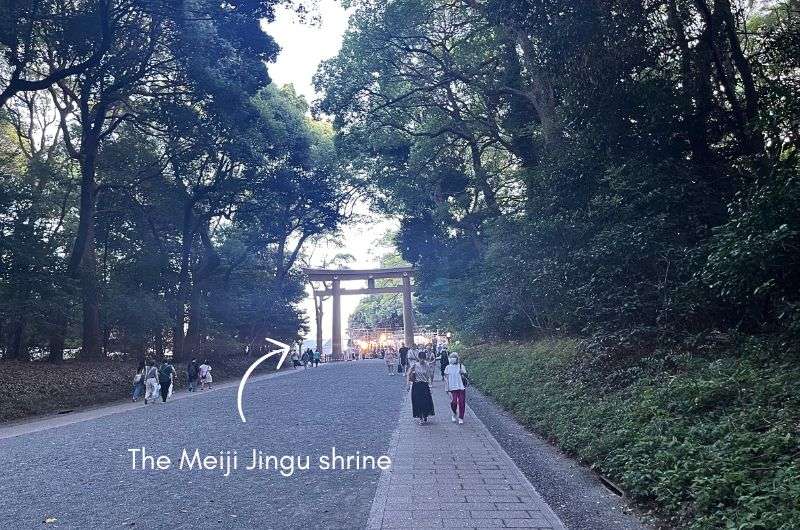
Access to Meiji Jingu is a walk through a nice park
Distance from the last stop: 5-minute walk to the gate
Time spent here: 1 hour
The first of your 3 days in Tokyo is coming to an end! I think you’re almost ready for dinner, just about now, but muster up your leftover energy because you still have a shrine to visit! It’s right there across the road from Takeshita Street, so don’t be lazy and get out there.
It’s called Meiji Jingu, a Shinto shrine surrounded by a gorgeous, forested park that feels like a peaceful retreat. Actually, you won’t immediately even see the shrine, because it’s about a 10-minute walk through the forest to get to the shrine from any of the gates.
A forest fit for an Emperor!
The lush forest stands as a testament to the love the Japanese people hold for Emperor Meiji and Empress Shoken, the ones who modernized and westernized Japan after centuries of relative isolation under the previous shogunate.
The story goes that when the shrine was established in 1920, over 100,000 trees were donated and planted by volunteers from all over Japan. This act of unity and dedication created the serene forest that visitors walk through today, making the approach to the shrine as significant as the shrine itself.
Tip: Read about shrine etiquette in my guide to Japan’s best temples and shrines.
What’s up with all the horses?
Horses hold a special place in the history and rituals of Meiji Jingu. Historically, horses were considered sacred messengers of the gods in Shinto, and donating a horse to a shrine was a highly esteemed offering—everyone wanted in on that.
In the past, wealthy patrons and the nobility would donate live horses to Meiji Jingu as a tribute to the deified spirits of Emperor Meiji and his wife. Over time, this practice disappeared due to practical reasons.
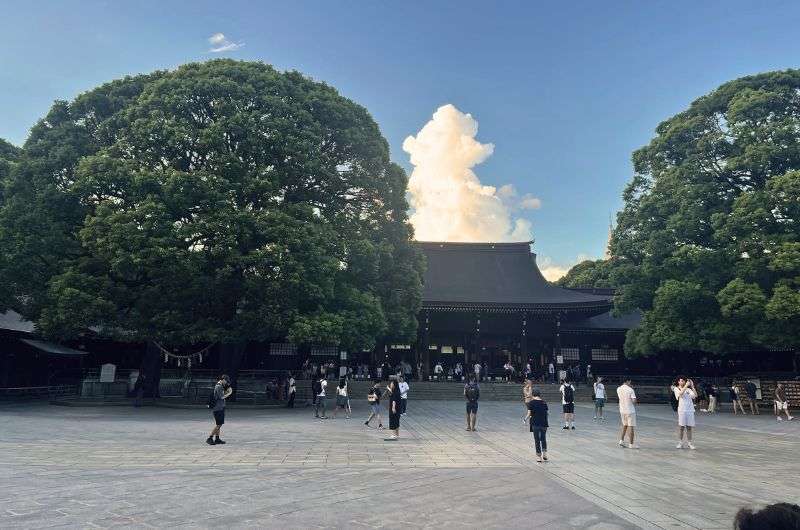
And the last stop of the day is behind us
Now, instead of live horses, worshippers donate ema, small wooden plaques with horse images or drawings on them. You can participate in this symbolic action and buy an ema for JPY 500. You’ll see hundreds of them hanging around the tree in front of the main shrine.
But I’d love to see you try to donate a live horse! Would they turn you away? Wouldn’t that be bad luck? Would they tell you to park the horse next to the Ema tree? I have so many questions.
Tip: Just a short walk from Meiji Jingu is Yoyogi Park, a great place to relax, enjoy cherry blossoms in spring, or watch locals showcase their talents.
Getting to Meiji Jingu
The most convenient entrance gate to Meiji Jingu is right behind Harajuku Station, which is where you are if you’ve just finished walking/shopping/being annoyed at Takeshita Street. So just walk right in. There is no entrance fee. All you need to remember is that Meiji Jingu closes at sunset.
- Open sunrise until sunset
- Free entry
Your first day in Tokyo is coming to an end. Head back to your hotel (I recommend Nohga Hotel Akihabara Tokyo), get cleaned up, unload all the souvenirs you bought on your tour through Tokyo’s highlights, and head out to dinner. If you’re too tired to care to go anywhere, you’ll be pleased to know that Nohga Hotel Akihabara has a very decent restaurant on site.
But before you even try to eat in Japan, read my guide to Japan’s food culture and the best food, drinks, and restaurants. That way, you’ll know not to tip, that sashimi isn’t sushi, and how to stop them from refilling your sake over and over.
Day 1, stop 8: Karaoke
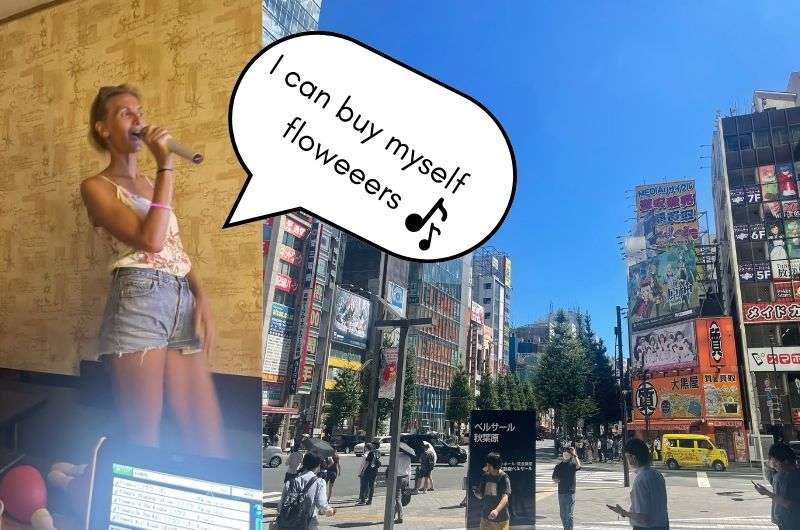
My girlfriend, having the time of her life
Time spent here: 1.5 hours
But wait! Don’t go to bed just yet—it’s time for one last very Japanese experience—karaoke! I can’t say it’s something I’d do at home, but in Tokyo, it felt like a must-do.
No regrets there, because now I can die peacefully knowing that I am excellent at rapping (not so much at rock apparently)! If you don’t sing karaoke in Tokyo, you haven’t been to Japan. It’s so much fun!
What to expect at karaoke houses in Tokyo
Karaoke in Tokyo is a completely crazy experience—imagine a 7-floor building where each floor is lined with one tiny karaoke room next to another, and it is PACKED with people belting all the top hits you can think of. Hilariously, everyone is singing way worse than they think they are (not me).
Some of the most popular karaoke chains are: KaraokeKan, Big Echo, Shidax, and Uta Hiroba, and you’ll find them all over Tokyo, Akihabara included.
Here’s how it works:
Go to the reception and ask for a karaoke booth based on the number of people in your group. Booths are usually booked by the half-hour or hour and paid per person. You’ll be given a booth number to go to. Prices depend on the time you visit (weekends and evenings are more expensive), but let’s say you should expect JPY 1000 per person per hour.
Once you’re in your booth, it’s pretty easy to find your way around the tablet with song choices if you remember to switch it to English. It is standard (and sometimes mandatory) to order drinks and food, too, usually on the tablet where the song choices are. They run you a tab, and you pay your balance when you check out.
Some places even have costumes that you can borrow if you want to dress the part, or maybe for a confidence boost, or maybe to act out some weird fantasy, who knows. I was awesome even in my regular clothes, so... If you really want to rock out, you can rent a mic stand sometimes, too.
You’ll go to sleep tonight feeling like a rock star!
Day 2 of Tokyo itinerary: Ghibli Museum and Skytree
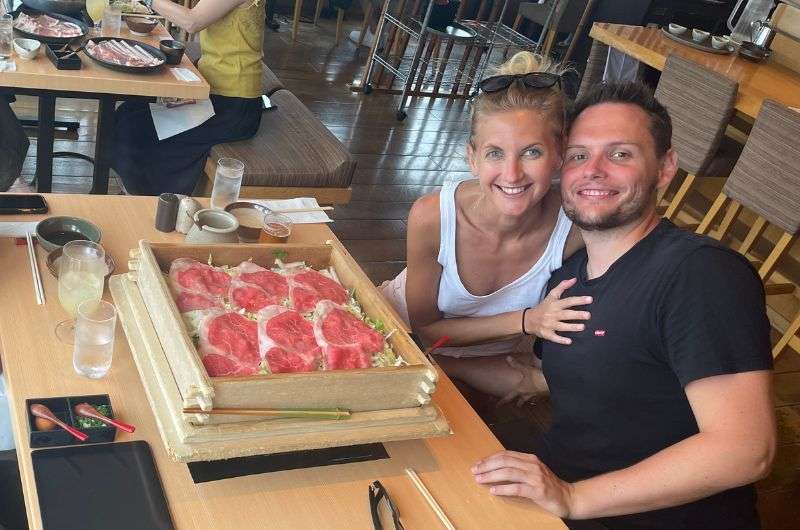
Good morning! Time for some nice views and museums! Loved the shabu shabu at this restaurant.
Main sites visited on day 2: Ghibli Museum, Tokyo Skytree
Restaurant tips: Koyoken | Kazu (both near Skytree)
Further reading: Tokyo Best Places to See
Today is your second (and last) full day in Tokyo. Tomorrow, you’ll be heading outside of town. Realistically, though, you saw all of Tokyo’s best places yesterday, so today you’ll take it a little bit easy.
Yes, you only have 2 places on your itinerary. How very unlike me! But it’s because they’re more time-consuming than yesterday’s “a street with weird shops” and “a street with expensive shops”.
Day 2, stop 1: Ghibli Museum
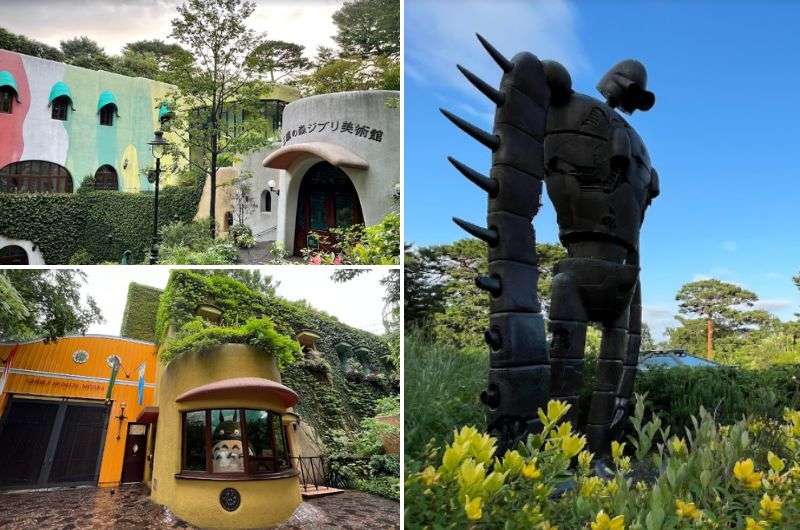
Can you spot Totoro welcoming visitors at the Ghibli museum?
Distance from the last stop: 45 minutes to an hour by train + walk or shuttle bus
Time spent here: 1.5 hours minimum
You might leave your first stop of the day surprised, much like I was, that the Ghibli Museum may be the highlight of your Tokyo itinerary! I’m not an anime fan or anything, but the museum's like stepping into a Miyazaki film—whimsical, unexpected, and utterly captivating. Right from when you spot Totoro standing at the ticket desk window, you’ll turn into a kid again.
How the Ghibli Museum is organized
You’ll notice that the building and museum grounds themselves are colorful and cutesy, so you’ll be in anime mode the moment you get there. Once inside, it's a feast for the senses, with exhibits that bring to life the studio's iconic films, like Princess Mononoke, Kiki's Delivery Service, or My Neighbor Totoro, all rooted in Japanese art and storytelling traditions.
The museum itself might not be sprawling, but the 3 floors and rooftop (with Laputa waiting for you up there) are packed with Ghibli awesomeness.
You’ll get to learn a little about how Ghibli films are made, too. I say ‘a little’ because you won’t find any English translations, so a lot is left up to your imagination, but hey, where else would that be fitting than in an anime movie museum? Who needs words when you're being spoken to in the universal language of wonder!
There’s a film you can see exclusively at the Ghibli Museum!
Make sure to see the museum-exclusive short film. Overall, set aside at least 1.5 hours to get through the entire museum. You can end your visit with a drink at the on-site café. It doesn’t suck!
Pro tip: If you’re visiting during cherry blossom season, consider stopping at Inokashira Park near the Ghibli Museum for beautiful views of cherry blossoms reflected in the lake.
Getting to the Ghibli Museum in Tokyo
The Ghibli Museum is in Mitaka, which is to the west of Tokyo city center, accessible by train or car (there’s a parking lot in front of the museum).
Say you’re staying in crazy Akhibara (like where we stayed and can recommend: Nohga Hotel Akihabara). From Akihabara Station, get on the JR Yamanote Line or the JR Keihin-Tohoku Line heading towards Shinjuku or Shibuya. Get off at Yoyogi Station and transfer to the JR Chuo Line (Rapid) heading towards Takao or Mitaka. You’ll be getting off at Mitaka Station in a total of 30–40 minutes.
If you’re staying at a different hotel, I have no idea how you get to the Ghibli Museum. But let’s pretend you’re going to the Ghibli Museum from Tokyo Station. You’ll need to board the JR Chuo Line (Rapid) heading towards Tachikawa or Takao, and in 30 minutes, you’re at Mitaka Station—no transfers.
Once you arrive at Mitaka Station, it is a 15-minute walk to the museum, or hop on the Ghibli Museum dedicated shuttle bus that runs from the south exit of Mitaka Station. The bus is decorated with cute Ghibli characters, making it easy to spot.
• Open daily: 10 am–6 pm
• Ticket cost: JPY 1000 for adults
Day 2, stop 2: Tokyo Skytree (not Tokyo Tower)
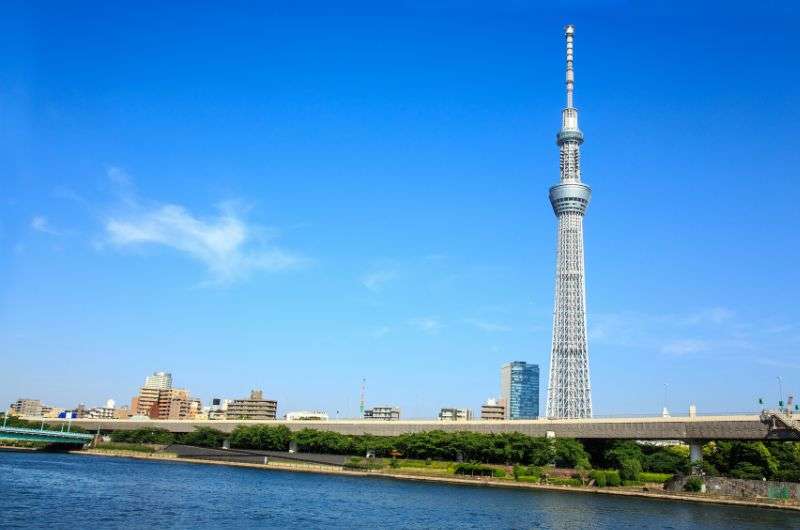
Distance from the last stop: 1 hour on trains/metro
Time spent here: 1.5 hours unless you don’t have your tickets and spend an hour waiting in line + time for lunch and coffee
I’m sure that by now you’ve seen Tokyo Skytree many, many times while galivanting around the city—it dominates Tokyo's skyline not just by being tall, but by being the tallest tower in the world at a staggering 634 m (2,080 ft). Now, that's what I call doing it Tokyo style—going big or going home, and Skytree certainly doesn't go home.
Disclaimer: While Tokyo also has the iconic Tokyo Tower, I figured one tower per city was enough, and I chose the bigger, better one. Skytree simply outshines it in both height and modernity, offering a more elevated experience—literally.
The observation decks at the Skytree
The Tokyo Skytree will redefine your idea of 'panoramic.' It’s official, the respectable job is being a broadcasting tower. But, just like Clark Kent, he has something a little more fun up his sleeve, too—two eye-popping observation decks, complete with spiral staircases and a glass floor that’ll leave some people white-knuckling the walls! Not me, I was as cool as a cucumber... on the outside, haha.
Reaching the first observation deck, I was hit with a 'this is it' moment—the Tokyo view I'd been craving. It's like seeing the world curve at your feet. Spotting Mt. Fuji on the horizon is like icing on this sky-high cake.
If you visit Skytree closer to nighttime, you can see it in all of its illuminated glory. They alternate between a few colors, so you never know which you’ll be getting.
Purchase tickets online in advance to skip lines
Ticket lines can be as long as the tower is tall, so buy them in advance on the official website (up to 30 days in advance). If you can’t plan to save your life, you can still at least buy same-day tickets online (for a little extra money). Even that is better than just rocking up and hoping to catch a break.
Then again, if you wait in line long enough, maybe they’ll turn on the nighttime lights by the time you get inside!
Even though it’s not Tokyo Tower, the Skytree’s sheer scale, design, and views make it a must-see and my top pick for Tokyo’s tower experience.
Lunch near Tokyo Skytree
Give Koyoken a try if you don’t mind not having an English menu and you love pork. It’s very traditional and very good—it’s a perfect spot to sample authentic Japanese food.
Kazu is a fantastic BBQ place. Just be warned, they barbecue all the things.
Finally, there are also a couple of restaurants in the Skytree itself. Expect high prices and great views.
Getting to Tokyo Skytree
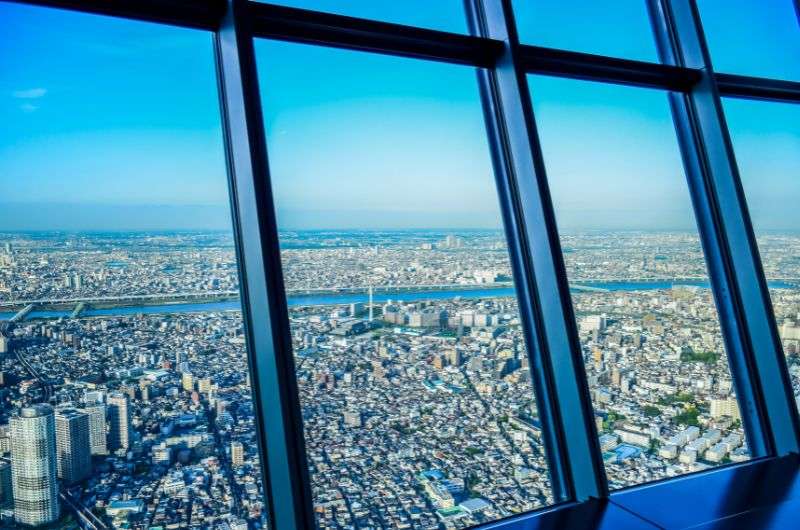
Observation decks on the Skytree
The closest stations to the Skytree are Tokyo Skytree Station and Oshiage Station. Here’s how to get to either from the Ghibli Museum (they each take about an hour):
For Tokyo Skytree Station (2 transfers): At Mitaka Station, board the JR Chuo Line (rapid) heading towards Tokyo. At Kanda Station, switch to the Tokyo Metro Ginza Line towards Asakusa. Once you arrive at Asakusa Station, transfer to the Tobu Skytree Line and take it to Tokyo Skytree Station, which is right at the base of the tower.
For Oshiage Station (1 transfer): Start from Mitaka Station and take the JR Chuo Line (rapid) to Nippori Station. This avoids the need to transfer at busy stations like Kanda. Transfer to the Keisei Line and head towards Oshiage Station. Once you're there, Tokyo Skytree is just a short walk away.
Day 3 of Tokyo itinerary: DisneySea or Kamakura day trip

The last day is a fun day! DisneySea, here we come!
Main sites visited on day 3: DisneySea or Kamakura day trip
Further reading: Tokyo DisneySea Guide
On the final day of your three days in Tokyo, I recommend spending it at DisneySea or taking a day trip to Kamakura.
Listen—I don’t have kids, am pretty hard to please, and get bored easily, and I still thoroughly enjoyed DisneySea. It was a fantastic day out for my girlfriend and me, and I can almost guarantee anyone reading this will enjoy it too.
If you’re 100% certain you don’t want to go to DisneySea (I get it, some people are just no fun), go on a day trip instead. I’ll give you options below. Or just go to DisneySea anyway, and one of us gets proved wrong.
Option 1: DisneySea
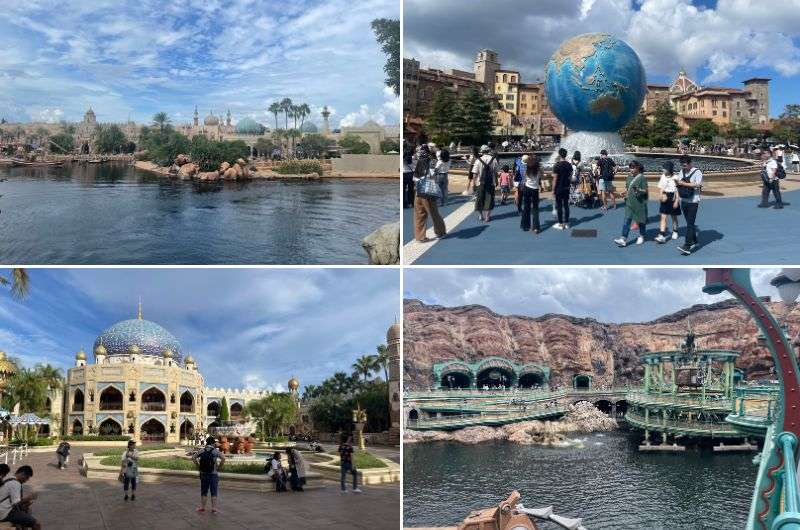
Disney Sea in Tokyo is one of its kind!
DisneySea, the only one of its kind globally, has a slightly more grown-up vibe than Disneyland (like a tad, nothing major, there are still children everywhere, and rides for little kids too). All of the reviews I’ve read say DisneySea is the best out of all the Disneylands worldwide, so if you’re on the fence about going, take a leap to the Disney side.
My experience at DisneySea
My first tip is to get there early. Tickets are around USD 60, but then comes my second tip: you’ll want those priority passes once you see the queues—or, if you're as neurotic as I am, splurge on a timed entry and breeze past the masses.
I love how DisneySea has an actual harbor with a steamboat, you can see they had the budget to make it truly a place “where imagination and adventure set sail” (the official tagline). Despite the sea in its name, there's ironically just one water ride at DisneySea.
My favorite parts of DisneySea were the Arabian Coast (I loved Aladdin as a kid!) and Toy Story, which I honestly didn’t even know was Disney. The Tower of Terror is a huge building and one of the main focal points of the park. It was… completely different from what we expected, and boy, is that drop tall!! I don’t want to give you any spoilers, but it was a thrill. Even waiting in line was exciting—if you like to be freaked out.
As is standard in Disney Parks, even waiting in line is usually quite entertaining, though we only ever waited 15 minutes max thanks to fast passes, so I can’t say how much I’d like it if we were stuck there for 45 minutes.
Just know that if the line seems to be short or moving fast outside, it may be a completely different story once you get inside. They zig-zag the heck out of those waiting areas.
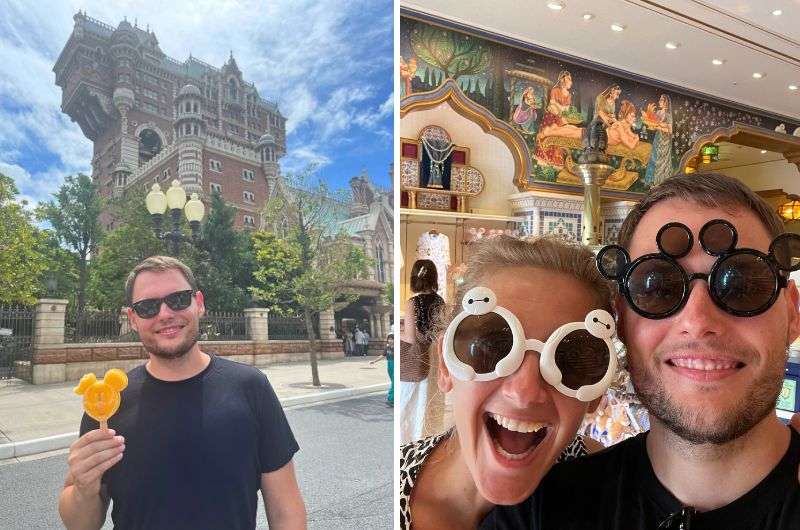
Disney Sea is a good alternative to enjoy your last day in Tokyo!
Other DisneySea highlights, like the Journey to the Center of the Earth ride, with its dark tunnels and monster exhibits, make you forget you're in a theme park and not on some sci-fi adventure. Very much appreciated by the childless visitor!
Some places, like Fortress Exploration, had me wondering what Disney movie they’re supposed to be from. And don’t get me started on the Venetian Village. It was like wandering into a Renaissance fair by accident.
My last tip is to save Soaring: Fantastic Flight for later in the day when the queues die down, or just get that fast pass. The 3D waiting room alone is worth it, never mind the sensation of flying across the world in 5 minutes.
My top tips for visiting DisneySea:
• Get there early, because the day is short when there’s so much to experience.
• Splurge on fast passes—they save so much time and sanity. You breeze past the long lines!
• Leave the Soaring: Fantastic Flight ride for later in the day if you don’t follow my other tip and don’t purchase a Fast Pass.
Getting to DisneySea from central Tokyo
If you’re going to DisneySea from central Tokyo (Tokyo Station), get a train on the JR Keiyo Line or JR Musashino Line heading towards Maihama Station, which is the gateway to the Disney resorts. Once you arrive at Maihama Station (it’ll take a maximum of 20 minutes), exit and transfer to the Disney Resort Line. This is a monorail service that circles around the Tokyo Disney Resort, including stops at Tokyo Disneyland and Tokyo DisneySea. It's just one stop from Maihama Station to Tokyo DisneySea Station on the Disney Resort Line.
Or, if you’re staying at the same hotel we stayed at— Nohga Hotel Akihabara Tokyo—and are now screaming at your screen “Hey Jan! You made me stay in Akihabara and you’re giving me directions that aren’t from Akihabara?!”, this is for you: At Akihabara Station, board the JR Yamanote Line or the JR Keihin-Tohoku Line going towards Tokyo Station or Shinagawa Station. Get off at Tokyo Station and then follow the instructions above.
Option 2: Day trip to Kamakura, Nikko, or Hakone
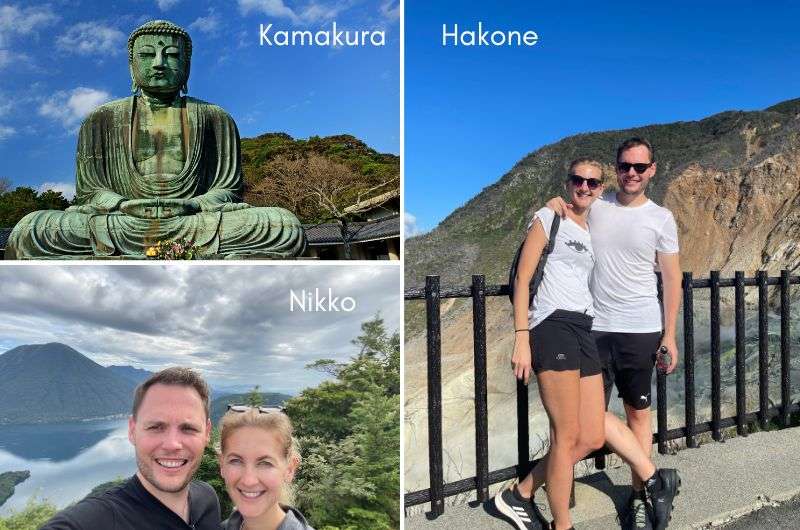
Kamakura is perfect for a one-day trip. For Hakone and Nikko, definitely plan more!
Nikko and Hakone really deserve more time
If you decided against DisneySea, I want to tell you that Nikko and Hakone were some of my favorite places in all of Japan, so I’m telling you NOT to go there on a day trip unless you absolutely have to.
If your Japan trip includes time for Nikko and Hakone, I strongly recommend spending at least two full days in each. Both Nikko and Hakone are 1.5 – 2 hours away from Tokyo.
Nikko is a postcard come to life, and Hakone is Mt. Fuji! But also pirate boats, pagodas, and smelly volcanic landscapes. I wrote a separate 2-day itinerary for Nikko and another 2-day itinerary for Hakone, so check those out if you’re trying to see them properly.
Visiting Kamakura from Tokyo
Kamakura, on the other hand, is easily seen as a day trip from Tokyo. It’s ex-political capital meets beach town, with some hikes thrown in for good measure. Some people call it the “Kyoto of eastern Japan” for its high number of temples and shrines, but if you go to real Kyoto, you’ll beg to differ. Kamakura's about an hour away from central Tokyo by train.
The vibe in Kamaruka is a mix of spiritual tranquility and seaside relaxation. I steer clear of hippie towns, but Kamakura manages to stay more in surfer dude territory and less in obnoxious tie-dye and crystals land.
The biggest attraction, literally, is the Great Buddha, one of the largest bronze Buddha statues in Japan. You can also visit shrines like Hasedera, set against a backdrop of lush greenery. Or get lost in the bamboo groves of Hokokuji (and compare them to those of the more famous Arashiyama Bamboo Forest), or just hang out by the beach.
Is 3 days enough for visiting Tokyo?
I think three days in Tokyo is more than you need if you’re just trying to see the city’s highlights! There are so many other places in Japan that deserve your attention more than Tokyo, Kyoto, Nara, Hakone, and Nikko, just to name a few. I know it’s hard to believe because Tokyo is supposed to be the bee’s knees, but it fell very short of my expectations.
What do I mean by that? It’s just a big, busy city with not much to do. After a day or two, you’ve seen all there is to see in Tokyo and should be starting to feel restless and ready to move on.
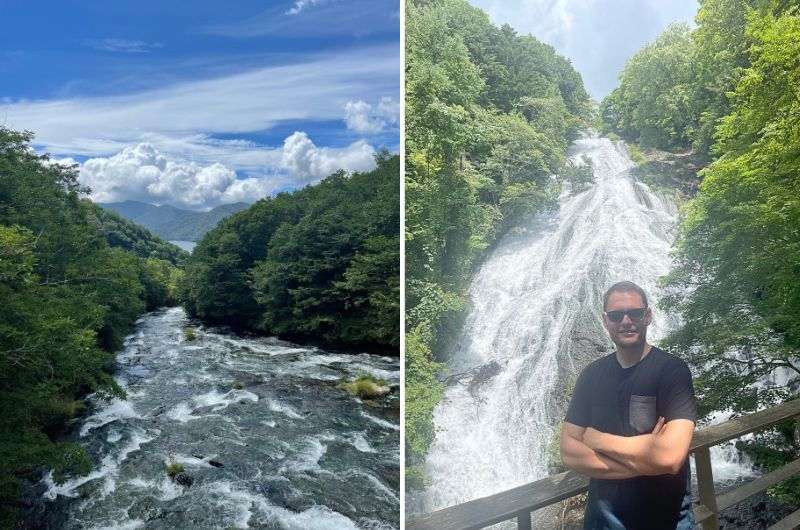
There is sooo much more to Japan than just Tokyo! For example, try Nikko!
Is Tokyo better than Kyoto?
The only thing I liked better in Tokyo than in Kyoto is the karaoke! Tokyo is just about the least Japanese place in Japan, and I didn’t think it was worth spending more than a day or two there. Kyoto, especially if you add nearby Nara and Osaka to the mix, trumps Tokyo in every way: history, temples and shrines, vibe, people, sights, scenery... need I go on?
Check out this 4-day itinerary for Kyoto and see that I barely fit it all in! Three days in Tokyo, on the other hand, is more than enough to see all the sights.
Essential travel tips for Tokyo (and Japan!)
Tokyo is probably going to be your first stop in Japan, and I can promise you it’ll be a sensory overload and complete culture shock. To make sure you’re prepared (and not that clueless tourist everyone pities), here are my no-nonsense travel tips:
• Japan’s love affair with cash: You’d think a country with robots serving coffee would be all about credit cards, but nope—cash still rules. Something about being traditional and more personal. Always have yen on you.
• No tipping: In this country, providing excellent service is a source of pride, not extra income! Tipping is unnecessary—actually, it’s rude. Save your cash and just say thank you with a smile.
• Cheap but incredible food: Japan is expensive, but the food isn’t. This was a lovely surprise for me. And after this trip, you’ll never look at sushi the same again. It’s on another level!
• Navigating trash disposal: Good luck finding a trash can—they’re practically extinct! Yes, the streets are spotless, and yes, it’s because everyone hauls their trash around like it’s their pet.
• Learn basic bowing etiquette: Don’t overthink this—no one’s going to judge your tourist bow. A simple head nod is fine, and any effort will be appreciated. But if you want to go full-on cultural chameleon, remember: straight back, 45° angle, hands at your sides.
• Visiting shrines: Japan has both Shinto and Buddhist shrines, and they’re not the same thing. At Shinto shrines, clap twice after making your offering. At Buddhist temples, keep it quiet and bow instead. Check out my guide to shrine etiquette in Japan for the full rundown.
• Mind your socks: Shoes come off everywhere—temples, shrines, traditional restaurants, even some hotels. Do yourself a favor and pack decent socks.
• Don’t visit in August: Japan in August is a sweaty, sticky nightmare. I know, because I went in August! Next time, I’m aiming for the fall; it must be beautiful with colorful foliage.
• The mosquito situation: If you’re there between May and September, be ready to wage war on mosquitoes. Bring or buy repellent.
• Cultural quirks to note: Blowing your nose in public is a no-no. If you have to, step aside and do it quietly. And those warm towels at restaurants? They’re for your hands, not your face. Don’t make it weird.
For even more brutally honest tips and insights, check out my full guide to Japan travel tips. Because you know you’re using your chopsticks wrong!!
This post contains affiliate links. I earn a small commission if you make bookings through my links, at no additional cost to you. Thank you for your support!




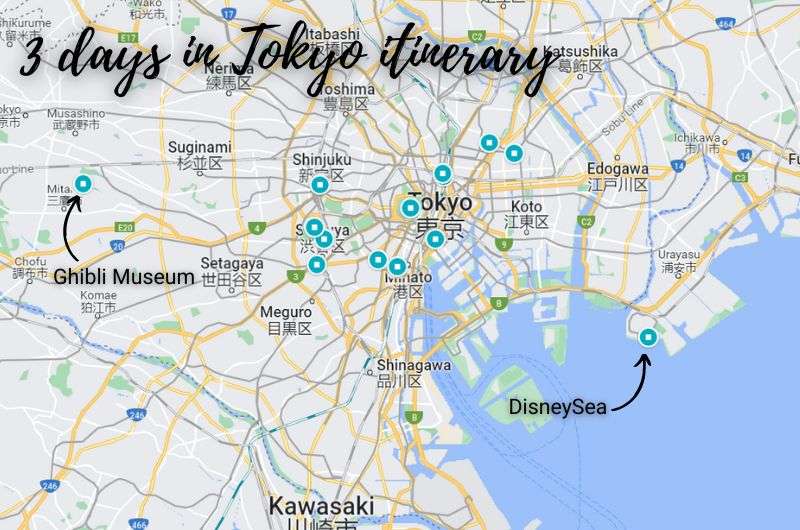
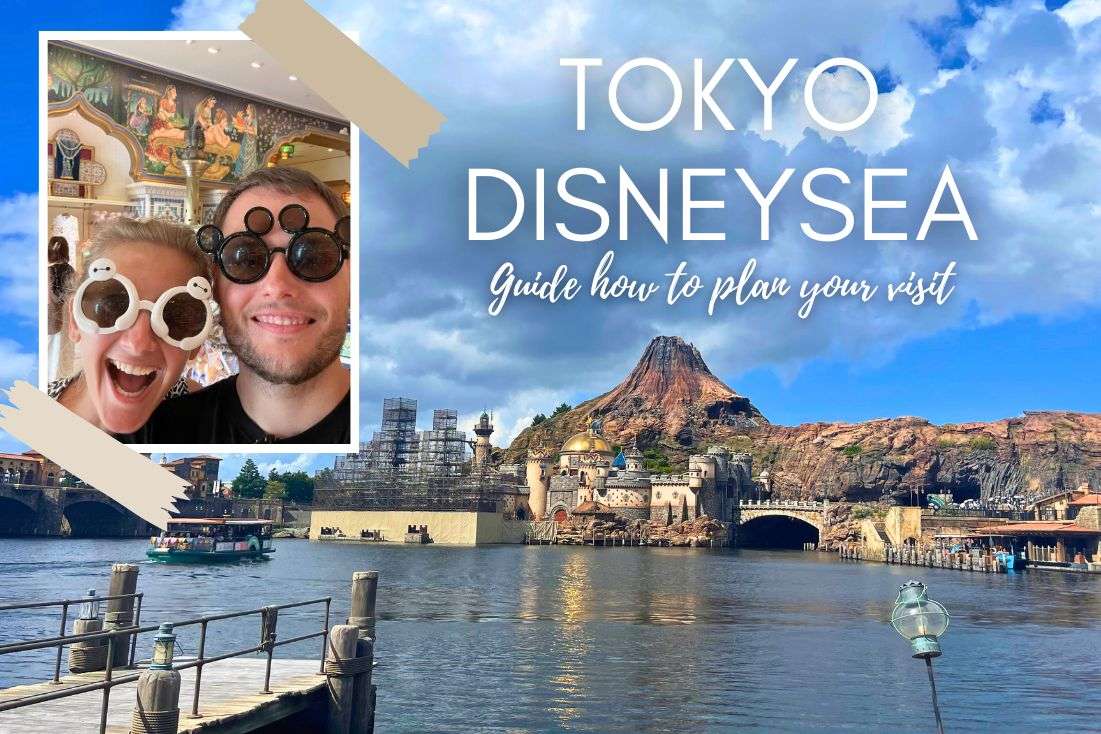
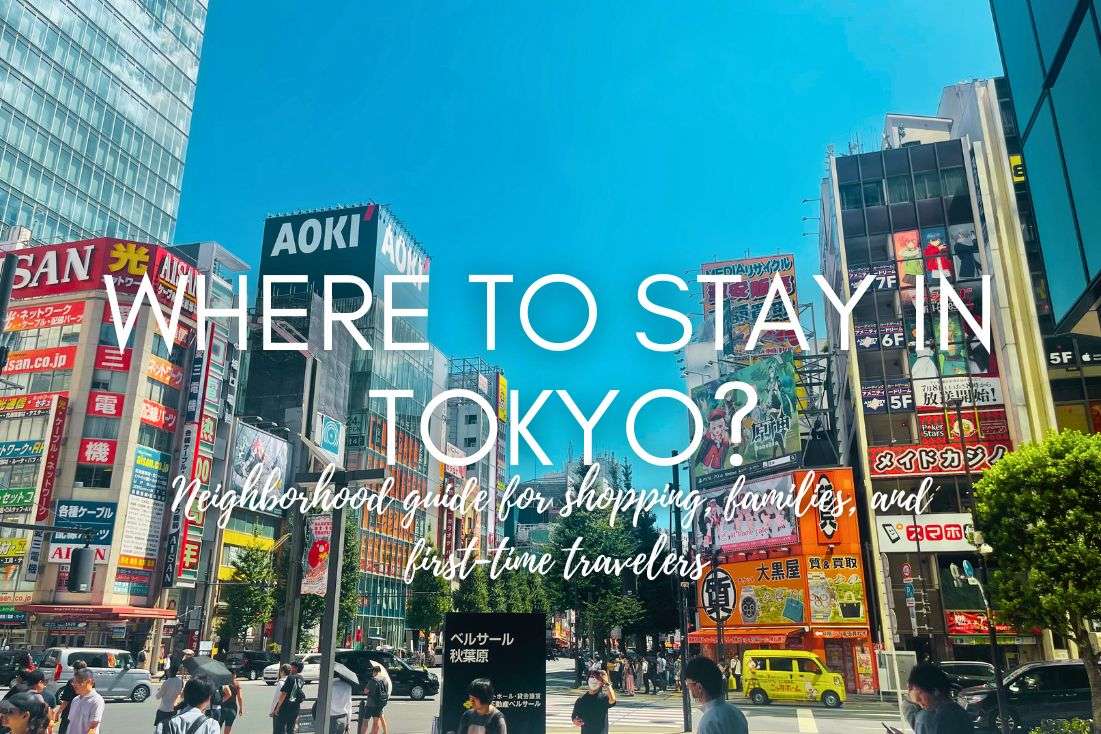
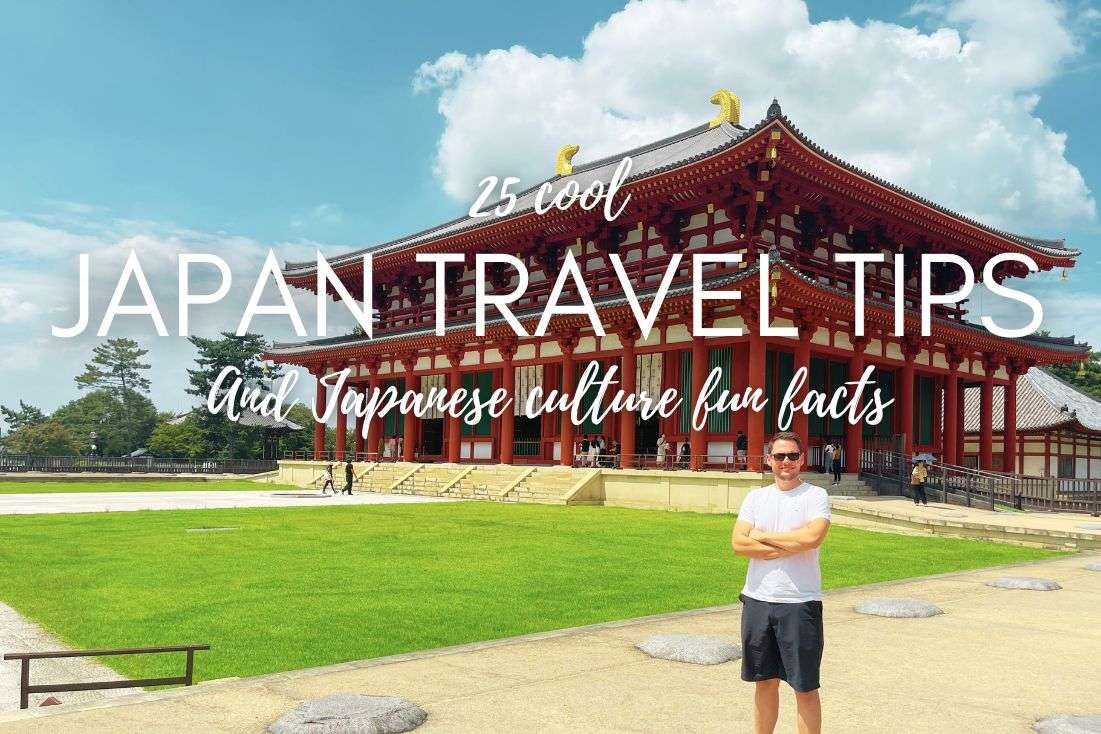



Comments | Thoughts? Give us a shout!